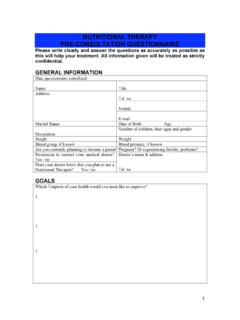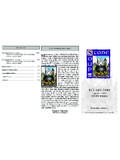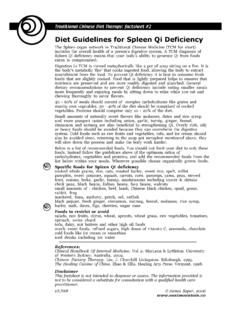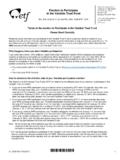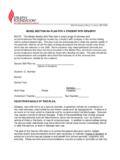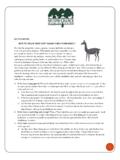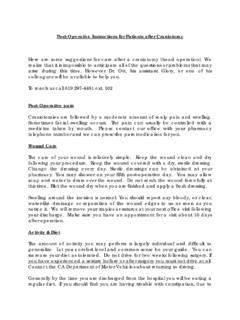Transcription of Patient Instructions: Cervical Artificial Disc (Disc ...
1 Patient instructions : Cervical Artificial disc ( disc Replacement). Surgical Technique Cervical disc replacement is a newer surgical procedure to treat damaged Cervical discs where motion preservation is desired. Its goal is to relieve pressure on the nerve roots or on the spinal cord and/or treat a painful disc while allowing the normal neck During surgery, the soft tissues of the neck are separated using minimally invasive techniques. The disc is then removed and pressure is taken off of the nerve roots and spinal cord using an operating microscope and microsurgical technique. After removing the disc , an Artificial device is inserted into the disc space. Depending on the disc design, the device may be held in place with small screws.
2 Occasionally, despite the desire to maintain the normal motion with a disc replacement, the disc space will fuse together over time. Please visit for more information. Before Surgery Seven (7) days before surgery do not take any anti-inflammatory NSAID medications (Celebrex, Ibuprofen, Aleve, Naprosyn, Advil, etc), as this could have adverse affects on your bone growth and healing, cause prolonged bleeding in surgery. Do not eat or drink anything after midnight the day before surgery. This means nothing to drink the morning of surgery, except you may take your normal medication with a sip of water if needed. This includes your blood pressure medicine, which in general should be taken. If you take insulin, consult your surgeon or primary care doctor about taking it before surgery.
3 Do not be late to check in on the day of surgery, or it may be cancelled. Bring your preoperative folder with you to the surgery and have when you check in. If you have a copy of your MRI or x-rays, please bring them with you to the surgery even if your surgeon has already seen them or might have a copy. Surgery may be cancelled if we do not have your radiographic images. Please be aware that smokers are recognized to have a significantly higher risk of postoperative wound healing problems, as well as operative and postoperative bleeding. Smoking disrupts the normal function of basic body systems that contribute to bone formation. Smokers understand and must agree to discontinue smoking for at least two weeks before and after surgery.
4 Although it helps to stop smoking for several weeks before and after surgery, this does not eliminate the increased risk resulting from long-term smoking. After Surgery Activity Level Do not lift more than 5-10 pounds for the first few weeks after surgery. This may be increased to approximately 20 pounds after 4-6 weeks. Do not lift anything greater then 20 pounds for the first 3 months. Avoid prolonged upright sitting on hard surfaces or long car rides (more than 3 hours) for 2-4 weeks. You may drive after about a week and as soon as it is comfortable to do so and when no longer under the influence of pain medications. Limited bending or twisting of the Cervical spine is advised. If physical therapy has been prescribed, you are not to perform range of motion, flexion, extension or lateral bending until fusion cleared by your surgeon.
5 Avoid activities with potentials falling or physical contact until cleared by your surgeon. Start walking as soon as possible after the surgery. Walking helps to prevent blood clots and increases muscle strength. Bandage Bandage (if present) may be removed the second day following surgery. Steri-strips should be left intact on the incision until returning to clinic or for your postoperative follow-up 7 to 14. days following surgery. Drain If you are discharged with a drain, you will need to track the daily output of the drain. You will be instructed prior to hospital discharge how to care for the drain and empty it. Almost all drains are removed within 7 days after surgery, but individual cases vary.
6 IF YOU HAVE A DRAIN, please NOTIFY the BNA office (303 938 5700) of the drain output EVERY OTHER business day, unless instructed otherwise. Bathing You may shower on third day following surgery. Try to limit showers to no more than 5-7 minutes. Do not scrub the wound. Let water run over the incision, then pat dry with clean towel. Do not soak in a bathtub, hot tub or pool for at least 2 weeks. Diet (Narcotic pain medications are very constipating; be proactive with stool softeners and laxatives). A high fiber diet is recommended. Avoid straining on the toilet. Keep stools soft with a high fiber diet and/or use of prune juice, Metamucil, Fiber One cereal, etc. Pain Medications Do not take NSAID medications (Ibuprofen, Naprosyn, etc.)
7 Or Cox-2 inhibitors (Celebrex,etc.) for 3-6 months following surgery. Tylenol can be taken as needed. Narcotic pain medications are prescribed if Tylenol is inadequate, Do not allow pain get out of control before taking medication or it will be less effective. We will not refill pain medications over the weekend or after hours. Anticipate the need for medication refills. Follow-up Call Boulder Neurosurgical Associates' (BNA) office (303-938-5700) and schedule your routine postsurgical visit for 7-14 days after surgery. Other follow-ups will be scheduled as needed. We generally follow patients for at least 2 years after surgery, often longer. Please call your physician's office immediately with any problems or go to the emergency department with progressive difficulty swallowing, difficulty breathing, significant neck swelling, new numbness or weakness, fewer greater than degrees or any other concerns.
8 Other FAQs How long will I be in the hospital? This varies depending on the type of surgery performed. For single, two and some three level surgeries, you will likely go home on the day of the surgery. Otherwise, you will go home the day following day. We have found that patients generally prefer the comfort and support that home offers. Going home sooner lowers your risk of complications, such as hospital-acquired wound infections, blood clots and urinary tract infections. How much time off from work? The amount of time needed for recovery prior to returning to work varies depending on the surgery, your job, and you. Typically, 1 week is sufficient, but patients should inquire of their surgeon for an individual recommendation.
9 For jobs requiring lifting and physical exertion, up to one month may be required. When can I resume driving? Driving is acceptable approximately one week after surgery depending on the use of pain medication. We generally recommend that you not drive while taking pain medications following the surgery. Driving after an Artificial disc replacement surgery must be done carefully as we do not recommend excessive turning of the head and neck. Will I wear a Cervical neck collar? The use of Cervical collar is generally not required after this type of Cervical surgery, but your doctor may prescribe it to avoid the extreme range of motion initially. Will I need pain medications? We will prescribe pain medications and other peri-operative medications on the day of surgery or prior to your discharge from the surgery center or hospital.
10 Will I need Physical Therapy? We usually recommend physical therapy and will refer you to a therapist at your first postoperative visit. Please limit bending and twisting of the Cervical spine. No pushing, pulling, or dragging and no range of motion (ROM) exercises for 3 to 6 months. Refrain from whiplash like motions, high impact activities, such as running, horseback riding, or any radical side-to-side motions. A good rule of thumb is, If it hurts don't do it'. What kind of follow-up is required? patients return to our office for routine follow up appointments at intervals that are determined on a case-by-case basis. We typically see patients back in the office within a couple weeks following surgery and then increase this to several months followed by annual exams.


